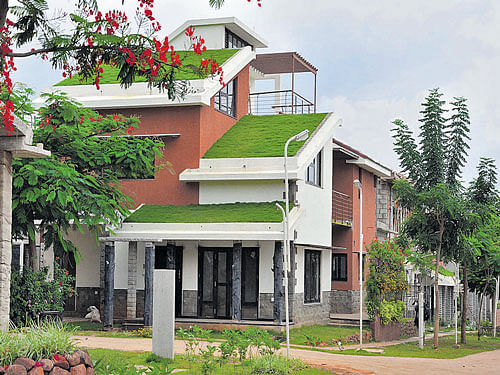
There are many things that can be done to make your home environmentally-friendly and sustainable. Bindu Gopal Rao explores how you can do so in a feasible manner, without compromising on the convenience and comfort factor.
As we celebrated the 69th year of independence, did you give a thought to the independence of your most-prized possession, your home? Is it possible for your home not to be so dependent on the grid – for electricity, water and the like? The good news is that you can take small steps to make your home independent in the true sense of the word.
Basic funda
If you are looking to buy a home, consider a project that aims to build a community which is independent in terms of natural resources. The place must attempt to bring about a sense of belonging among the residents towards the welfare of the community. Given the alarming rate of global warming, floods and droughts have become regular phenomena. The need of the hour is to build homes and infrastructure that can mitigate the damages caused by such natural disasters. Similarly, water and electricity are precious resources that need to be used intelligently. An environmentally-friendly home is one where a hygienic waste management system does not get jeopardised by an inefficient city waste management network, and air conditioners work at one-third the energy used by regular systems, These are houses that are well-ventilated; have floors that are friendly for residents suffering from rheumatoids and arthritis; their lush landscaping adding to the neighbourhood greenery and enhancing the quality of air, while reducing carbon dioxide in the air.
“We only use 30 per cent of energy from the grid; the solar power generation has no additional cost to the project or to the consumer. No water is exported, and no chemicals are used for the gardens or water treatment. There’s 70 per cent reduction in use of virgin steel; all wet waste is turned into compost, and rooftop or campus farming is a self-imposed regulation for every campus,” says Chandrashekar Hariharan, executive chairman and co-founder of BCIL Zed Homes.
Similarly, homes at GoodEarth Malhar are designed to have adequate natural light and cross ventilation, with provisions for solar water heaters and photovoltaic panels on the roof. “Having large windows, wide verandahs, air channels for circulation, and thermally conducive materials are features that can help one reduce the necessity for artificially installing light and ventilation.
Rainwater harvesting is an important activity at our property. Water from the roofs is collected through a network of pipes, which is then filtered to the main water tank. An on-campus sewage treatment plant recycles all waste water, with the water from the kitchens and bathrooms being treated with a series of bio-filters to emerge clean. This is reused in the toilet flushes and for irrigation in the gardens. Planting edible species in the gardens and encouraging a culture of vegetable gardening within the home are other aspects that are given importance to,” says Natasha Iype, director, GoodEarth.
Think long-term
As a home buyer, you have every right to ask your builder to commit to the number and kind of treatment systems employed in the project and to what extent it will affect your demand for water supply. Venkat Chalasani, CEO, Samskruti Builders, agrees that it’s a good idea to discuss waste management and rainwater harvesting options. “Our projects not only segregate the waste, but also use the methane gas produced while composting the green waste. Black and grey water is purified and reused for flushing and gardening. Additionally, in all our projects, we create enough capacity for storage tanks to collect the graded rainwater.
Purified, potable rainwater is supplied to the community. These measures ensure all our communities are 70-100 per cent self-sustainable in terms of water,” he says.
Decentralised waste management is where the wet waste is handled at the individual home level through pits or smart bins and the recyclable waste is directed to the appropriate agency. It also makes perfect sense to think of energy design installations that reduce the use of power, while not compromising on comfort and convenience. This will mean the use of solar energy systems. It will mean the use of biomass gasification to convert waste into electricity.
“This is about comfort and convenience. It is also about efficient planning, design and architecture in a way that we are not only addressing sustainability, but also other challenges of living in cities of the future. You have to be aware to ask your builder these pertinent questions before you make the decision to buy the house. In urban India, we are going to live with the nightmare of a power deficit for at least the next 20 years. If energy needs of 2030 are to be met, a 500-megawatt station should be commissioned every week for the next 10 years,” opines Chandrashekar.
Knowledge, they say, is power. Given that there is such a wide range of basic, viable systems and solutions that are available for your home, it’s about time that you made the smart choice.